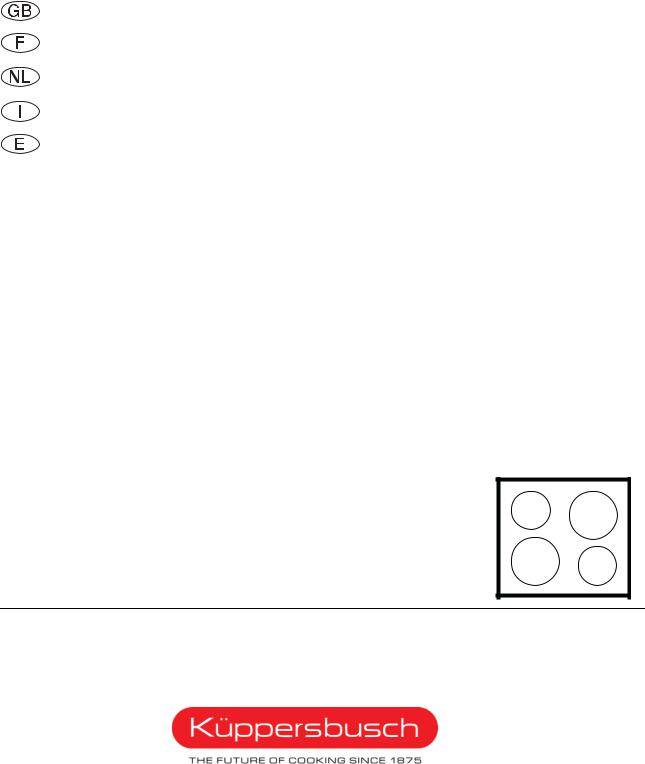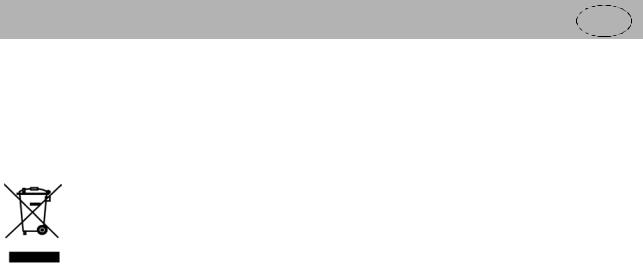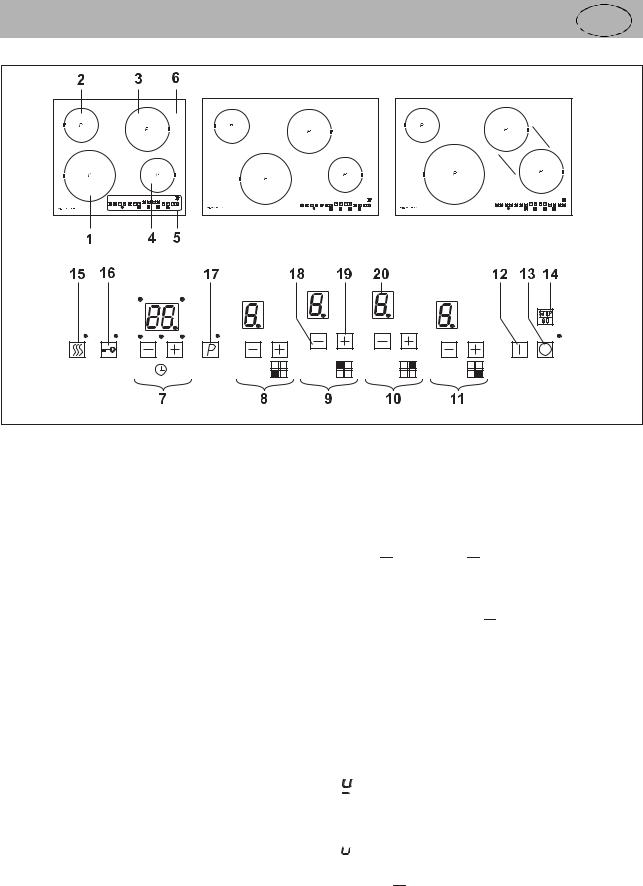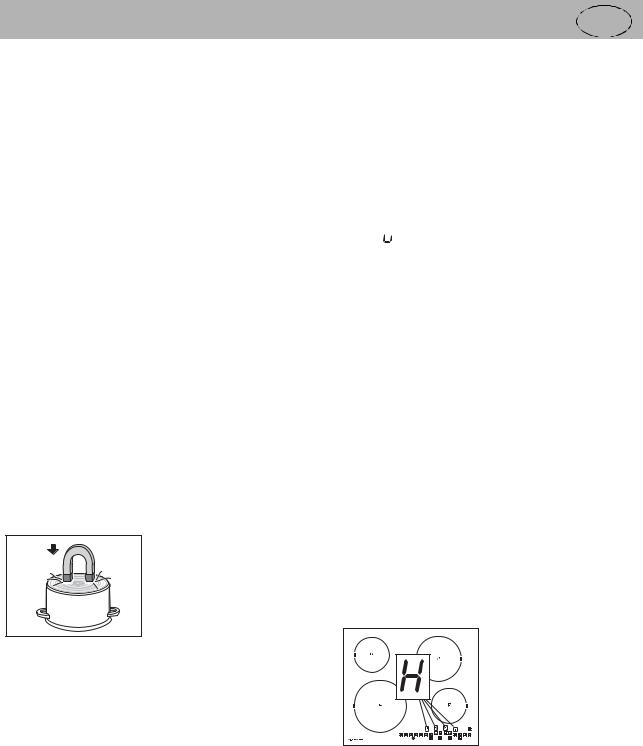Kuppersbusch USA EKI 607.2, EKI 848.0, EKI 807.2 User Manual

BEDIENUNGSANWEISUNG
mit Montageanweisungen
Instructions for use and installation instructions
Instructions d'utilisation et avis de montage
Gebruiksaanwijzing en montagehandleiding
Istruzioni di uso e di montaggio
Instrucciones de uso y de montaje
 Instruções de uso e de montagem
Instruções de uso e de montagem  ΟΔΗ ΙΕΣ ΧΡΗΣΗΣ ΚΑΙ ΣΥΝΑΡΜΟΛΟ ΗΣΗΣ
ΟΔΗ ΙΕΣ ΧΡΗΣΗΣ ΚΑΙ ΣΥΝΑΡΜΟΛΟ ΗΣΗΣ
EKI 607.2 / 807.2 / 848.0
225681 N91

Disposing of the packaging
Please ensure the environmentally-friendly disposal of the packaging that came with your appliance. Recycling the packaging material saves on resources and cuts down on waste.
Disposing of old appliances
The symbol on the product or on its packaging indicates that this product may not be treated as household waste. Instead it must be handed over to a collection point for the recycling of electrical and electronic equipment.
By ensuring that this product is disposed of correctly you will help to protect the environment and human health, which could otherwise be harmed through the
inappropriate disposal of this product. For more detailed information about recycling this product, please contact your local city office, your household waste disposal service or the shop where you purchased the product.
Appropriate use
The hob is to be used solely for preparing food in the home. It may not be used for any other purpose.
GB
For your information...
Please read this manual carefully before using your appliance. It contains important information on safety and on how to use and look after your appliance so that it will provide you with many years of reliable service.
Should your appliance develop a fault, please first consult the section on “What to do if trouble occurs?” You can often rectify minor problems yourself, without having to call in a service engineer.
Please keep this manual in a safe place and pass it on to new owners for their information and safety.
Safety instructions................................................................. |
20 |
Connection and operation..................................................... |
20 |
Concerning the hob .............................................................. |
20 |
Concerning persons.............................................................. |
20 |
Appliance description ........................................................... |
21 |
Operating the hob with the sensor keys ............................... |
21 |
Operation................................................................................ |
22 |
The hob................................................................................. |
22 |
Pan recognition..................................................................... |
22 |
Operating time limit............................................................... |
22 |
Other functions ..................................................................... |
22 |
Protection against overheating (induction) ........................... |
22 |
Cookware for induction hobs ................................................ |
23 |
How to cut power consumption............................................. |
23 |
Power settings ...................................................................... |
23 |
Residual heat display............................................................ |
23 |
Operating the keys................................................................ |
24 |
Switching on the hob and cooking zones ............................. |
24 |
Switching off a cooking zone ................................................ |
24 |
Switching off the hob ............................................................ |
24 |
STOP function ...................................................................... |
24 |
Locking ................................................................................. |
25 |
Childproof lock...................................................................... |
25 |
Automatic switch-off (timer) .................................................. |
26 |
Minute minder (egg timer)..................................................... |
26 |
Automatic boost function ...................................................... |
27 |
Keeping warm function ......................................................... |
27 |
Power boost setting (cooking zones marked with a P) ......... |
28 |
Power management.............................................................. |
28 |
Cleaning and Care ................................................................. |
29 |
Glass ceramic hob ................................................................ |
29 |
Specific soiling ...................................................................... |
29 |
What to do if trouble occurs ................................................. |
30 |
Instructions for assembly ..................................................... |
31 |
Note ...................................................................................... |
31 |
Safety instructions for kitchen unit fitters .............................. |
31 |
Ventilation ............................................................................. |
31 |
Installation............................................................................. |
31 |
Electrical connection............................................................. |
33 |
Technical data ...................................................................... |
33 |
Start of operation .................................................................. |
33 |
19

Safety instructions
Connection and operation
•The appliances are constructed in accordance with the relevant safety regulations.
•Connecting the appliance to the mains and repairing and servicing the appliance may only be carried out by a qualified electrician according to currently-valid safety regulations. For your own safety, do not allow anyone other than a qualified service technician to install, service or repair this appliance.
Concerning the hob
•Never allow the induction hob to operate unattended, as the high power setting (power max.) results in extremely fast reactions.
•When cooking, pay attention to the heat-up speed of the cooking zones. Avoiding boiling the pots dry as there is a risk of the pots overheating!
•Do not place empty pots and pans on cooking zones which have been switched on.
•Take care when using simmering pans as simmering water may dry up unnoticed, resulting in damage to the pot and to the hob for which no liability will be assumed.
•It is essential that after using a cooking zone you switch it off with the respective minus key and not just with the pan recognition device.
•Overheated fats and oils may spontaneously ignite. Always supervise the preparation of food with fats and oils. Never extinguish ignited fats and oils with water! Put the lid on the pan and switch off the cooking zone.
•The glass ceramic surface of the hob is extremely robust. You should, however, avoid dropping hard objects onto the glass ceramic hob. Sharp objects which fall onto your hob might break it.
•If cracks, fractures or any other defects appear in your glass ceramic hob, immediately switch off the appliance. Disconnect the fuse immediately and call Customer Service.
•If the hob cannot be switched off due to a defect in the sensor control immediately disconnect your appliance and call Customer Service.
•Take care when working with home appliances! Connecting cables must not come into contact with hot cooking zones.
•The glass ceramic hob should not be used as a storage area.
GB
•Do not put aluminium foil or plastic onto the cooking zones. Keep everything which could melt, such as plastics, foil and in particular sugar and sugary foods away from hot cooking zones. Use a special glass scraper to immediately remove any sugar from the ceramic hob (when it is still hot) in order to avoid damaging the hob.
•Metal items (pots and pans, cutlery, etc.) must never be put down on the induction hob since they may become hot. Risk of burning!
•Do not place combustible, inflammable or heat deformable objects directly underneath the hob.
•Metal items worn on your body may become hot in the immediate vicinity of the induction hob. Caution! Risk of burns! Non-magnetisable objects (e.g. gold or silver rings) will not be affected.
•Never use the cooking zones to heat up unopened tins of food or packaging made of material compounds. The power supply may cause them to burst!
•Keep the sensor keys clean since the appliance may consider dirt to be finger contact. Never put anything (pans, tea towels etc.) onto the sensor keys!
If food boils over onto the sensor keys, we advise you to activate the OFF key.
•Hot pans should not cover the sensor keys, since this will cause the appliance to switch off automatically.
•Activate the childproof lock if there are any pets in the home which could make contact with the hob.
•The induction hob may not be used when pyrolysis operation is taking place in a built-in oven.
Concerning persons
•Caution!
People who are not familiar with the built-in hob must only be allowed to operate it under supervision. Small children must always be kept away from the hob. Never allow them to play with the appliance.
•Attention!
The surfaces of the heating and cooking zones become hot during use. Keep small children away at all times.
•Persons with cardiac pacemakers or implanted insulin pumps must make sure that their implants are not affected by the induction hob (the frequency range of the induction hob is 20 - 50 kHz).
20

Appliance description |
GB |
1.Induction cooking zone front left
2.Induction cooking zone back left
3.Induction cooking zone back right
4.Induction cooking zone front right
5.Touch-control operating panel
6.Glass ceramic hob
7.Control keys timer
8.Control keys, front left cooking zone
9.Control keys, back left cooking zone
10.Control keys, back right cooking zone
11.Control keys, front right cooking zone
12.ON key
13.OFF key
14.Stop key
15.Warming key
16.Lock key
17.Power key
18.Minus key (lower)
19.Plus key (raise)
20.Power setting display
Operating the hob with the sensor keys
The ceramic glass hob is operated with touch control sensor keys. The sensor keys are operated as follows: lightly touch a symbol on the surface of the ceramic glass plate. A buzzer will indicate when the controls have been operated correctly. The touch control sensor key will then be indicated as “key”.
ON key  (12) / OFF key
(12) / OFF key  (13)
(13)
This keys are used to switch the entire hob on and off (main switch).
Minus key 

 (18) / Plus key
(18) / Plus key 

 (19)
(19)
These keys are used to set the cooking levels, the automatic switch-off device and the minute minder. The Minus key reduces the setting and the Plus key raises it.
The setting can be deleted by pressing both keys simultaneously.
Power setting display (20)
The power setting display shows the power setting which has been selected, or:
H ............... |
Residual heat |
P................ |
Power boost setting |
.............. |
Pan recognition |
A................ |
Automatic boost function |
STOP ........ |
Stop function |
L ............... |
Childproof lock. |
.............. |
Keeping warm function |
STOP key  (14)
(14)
The STOP function can be used to briefly stop the cooking process.
21

Operation
The hob
The hob is equipped with an induction cooking mode. An induction coil underneath the glass ceramic hob generates an electromagnetic alternating field which penetrates the glass ceramic and induces the heat-generating current in the pot base.
With an induction cooking zone the heat is no longer transferred from a heating element through the cooking pot into the food being cooked; instead the necessary heat is generated directly in the container by means of induction currents.
Advantages of the induction hob
–Energy-saving cooking through the direct transfer of energy to the pot (suitable pots/pans made of magnetisable material are required).
–Increased safety as the energy is only transferred when a pot is placed on the hob.
–Highly effective energy transfer between an induction cooking zone and the base of a pot.
–Rapid heat-up.
–The risk of burns is low as the cooking area is only heated through the pan base; food which boils over does not stick to the surface.
–Rapid, sensitive control of the energy supply.
Pan recognition
If a cooking zone is switched on and there is no pan on the zone or if the pan is too small, there will be no transmission of power. A blinking 
 in the cooking level display points this out.
in the cooking level display points this out.
If a suitable pot or pan is placed on the cooking zone, the power setting will switch on and the power setting display will light up. The power supply will be cut off when the pan is removed and the power setting display will indicate a blinking 
 .
.
If the pots and pans placed on the cooking zone are of smaller dimension, and the pan recognition still switches on, less power will be supplied.
Pan recognition limits
Cooking zone diameter |
Minimum diameter of the |
(mm) |
base of a pot (mm) |
|
|
145 |
90 |
180 |
120 |
210 |
135 |
260 |
170 |
|
|
GB
Operating time limit
The induction hob has an automatic time limit function.
The duration of continuous use of each cooking zone depends on the cooking level selected (see chart), provided that the setting of a respective cooking zone is not adjusted during use.
If the operation time limit has been activated, the cooking zone will switch off, a short signal will sound and an H will appear in the display.
The automatic switch-off function overrules the operation time limit, i.e. the cooking zone is only switched off when the period of time of the automatic switch-off device has expired (e.g. automatic switch-off after 99 minutes and cooking level 9 is possible).
Cooking level |
Operating time limit |
set |
in minutes |
|
|
|
120 |
1 |
520 |
2 |
402 |
3 |
318 |
4 |
260 |
5 |
212 |
6 |
170 |
7 |
139 |
8 |
113 |
9 |
90 |
P |
10 |
|
|
Other functions
If two or more sensor keys are pressed at the same time (e.g. when a pan is mistakenly put onto a sensor key) no function will be activated.
The symbol 
 will blink and a time-limited continuous signal will sound. After a few seconds the appliance will switch off. Please remove the item located in front of the sensor keys.
will blink and a time-limited continuous signal will sound. After a few seconds the appliance will switch off. Please remove the item located in front of the sensor keys.
To delete the 
 symbol press the same key or switch the hob off and on.
symbol press the same key or switch the hob off and on.
Protection against overheating (induction)
If the hob is used at full power for a longer period, it will not be possible to cool down the electronics system as required at a high room temperature.
In order to ensure that no excessive temperatures occur in the electronics system the power of the cooking zones may be reduced automatically.
Should E2 be displayed frequently during normal use of the hob and at normal room temperature, it is likely that cooling is not sufficient.
The reason may be that there are no openings for cooling purposes in the kitchen units or that there is no insulation. It may be necessary to check the installation of the hob.
22

Operation
Cookware for induction hobs
Cookware for induction cooking zones must be made of metal and have magnetic properties. The base must be sufficiently large.
Only use pots with a base suitable for induction.
Suitable cookware |
Unsuitable cookware |
|
|
|
|
Enamelled steel pots with a thick |
Pots made of copper, |
|
base |
stainless steel, aluminium, |
|
|
oven-proof glass, wood, |
|
Cast iron pots with an enamelled |
||
ceramic and terracotta |
||
base |
|
|
|
|
|
Pots made of multi-layer |
|
|
stainless steel, rustproof |
|
|
ferrite steel or aluminium with a |
|
|
special base |
|
|
|
|
This is how to establish the suitability of a pot:
Conduct the magnet test described below or make sure that the pot bears the symbol for suitability for cooking with induction current.
Magnet test:
Move a magnet towards the base of your cookware. If it is attracted, you can use the cookware on the induction hob.
Note:
When using pans suitable for induction from certain manufacturers, noises may occur which are attributable to the design of these pans.
Take care when using simmering pans as simmering water may dry up unnoticed, resulting in damage to the pot and to the hob for which no liability will be assumed.
How to cut power consumption
The following are a few useful hints to help you cut your consumption of energy and use your new induction hob and the cookware efficiently.
•The base of your cooking pots should be the same size as the cooking zone.
•When buying cooking pots, note that it is frequently the diameter of the top of the pot that it indicated. This is usually larger than the base of a pot.
•Pressure cookers are particularly low on energy and time required thanks to the pressure and the fact that they are tightly closed. Short cooking times mean that vitamins are preserved.
•Always make sure that there is sufficient fluid in your pressure cooker since the cooking zone and the cooker may be damaged as a result of overheating if the pressure cooker boils dry.
•Always close cooking pots with a suitable lid.
GB
•Use the right pot for the quantity of food you are cooking. A large pot which is hardly filled will use up a lot of energy.
Power settings
The heating power of the cooking zones can be set at various power levels. In the chart you will find examples of how to use each setting.
Setting |
Suitable for |
|
|
0 |
Off, using remaining heat |
|
Keeping warm function |
1-2 |
Simmering small portions. |
|
(lowest setting) |
3 |
Simmering |
4-5 |
Simmering larger quantities or roasting |
|
larger pieces of meat until they are |
|
cooked through. |
6 |
Roasting, getting juices |
7-8 |
Roasting |
9 |
Bringing to the boil, browning, roasting |
P |
Power setting (highest power output) |
|
|
Residual heat display
The glass ceramic hob is equipped with an H as a residual heat display.
As long as the H lights up after the cooking zone has been switched off, the residual heat can be used for melting food or for keeping food warm.
The cooking zone may still be hot when the letter H no longer lights up. Risk of burns!
The ceramic hob is not directly heated in the case of an induction cooking zone; it only heats up due to the effect of heat reflected by the pan.
23
